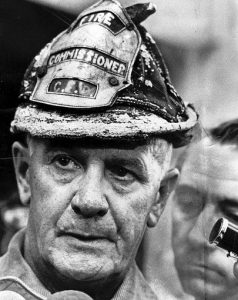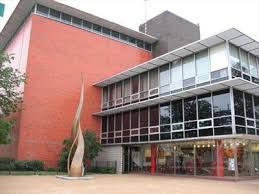Excerpts from chicagoandcookcountycemetaries.com:
The Battered Helmet
Fire Commissioner Robert J. Quinn is interviewed in front of Montgomery Ward and Co. on State Street on March 29, 1968. (Michael Budrys, Chicago Tribune)
Born in Chicago 12 May 1905, he was Nellie O’Boyle’s son. He began his career in the 1928 Chicago Fire Department candidate class. He served in the Navy in World War II and was decorated for heroism during a three-day battle against a fire on a tanker loaded with aviation fuel. He then served just shy of 50 years with the Chicago Fire Department.
He proudly wore a battered helmet, and in a 1971 interview said “I wouldn’t trade it for a solid gold one. I have worn that helmet since it was given to me the first day I entered the fire academy as a recruit. It was my good luck charm.”
His name was Robert J. Quinn, the fire commissioner of the Chicago Department between 1957 and 1978. He has been called an innovator and a leader.
He was named commissioner In March 1957 by Mayor Richard J. Daley replacing Anthony J. Mulleny. Quinn’s solid reign over the Chicago Fire Department corresponded with Daley’s hold on the city. At the Chicago Fire Alarm Office, he was simply known by his radio signature of 2-1-3.
Quinn was a hero early on. In 1934, he climbed eight stories to rescue three from a fire in a Loop building. The same year, he put a 200-pound woman over his shoulder and, with her clothing on fire, leaped 4 feet to an adjoining building.
As commissioner, Quinn presided over dozens of Chicago’s worst fires — including the horrific Our Lady of the Angels school fire, on December 1 1958, the Hubbard Street fire in 1961 in which nine firefighters died, the original McCormick Place fire in 1967, the blizzard of 1967, the 1968 Mickelberry Sausage factory explosion, and the 1968 West Side riot fires.
Quinn was a builder. In two decades Commissioner Quinn opened 36 large new fire stations and in 1957, he ordered the installation of radios in all fire apparatus. That enabled the fire alarm office to dispatch companies from one assignment to another, and allowed the fire companies to leave their stations to inspect buildings, drill, replenish fuel and supplies, yet stay in service via radio.
Quinn supervised the construction of huge water cannon deluge units known as “Big Mo” and “Big John” He acquired helicopters that gave fire chiefs a bird’s-eye view of a blaze and established a photographic unit
The old Drill School was replaced in 1961 by the modern Fire Academy Street. In 1871, on this same site, Catherine O’Leary’s barn then at 137 Dekoven, housed her cow who supposedly knocked over a kerosene lamp causing the Chicago Fire.
Quinn introduced new bureaus and services such as Air Sea Rescue which utilized helicopters and boats, manned by firefighter pilots and scuba divers The photography section was formed so fires could be documented and studied. The Bureau of Fire Investigation was formed with increased building inspections and education. The 911 emergency phone number to call fire, police, and ambulance service, was inaugurated in September, 1976.
He famously opposed switching from limousine ambulances to the boxy, modern vehicles, “apparently on the theory that a Chicagoan would rather die in style than be saved in the back of a panel truck,” the Tribune noted. However, the Emergency Medical Service (EMS) grew from 16 Cadillac ambulances in 1957 to 43 modular vans by 1977.
His biggest legacy however might be his title as “the Father of the Snorkel.” In 1958 he took notice of tree trimmers using an aerial platform . He then was instrumental in adapting the odd-looking hydraulic aerial work platform for the fire service . “A fireman in a crow’s nest at the top of the tower directs the stream and gets his orders from below by observers using a walkie-talkie radio,” the Tribune reported. The Snorkel revolutionized urban firefighting and enabled firefighters to stand firmly on a flat platform instead of precariously clinging to the top rungs of a ladder
That first Snorkel G-145 on a 1958 GMC chassis was put into service at Engine 1’s house 419 S. Wells St. on October 14 1958. It was used to fight the Our Lady of the Angels fire less than two months later. It was originally called Water Tower 4 along with three other 1920’s Seagrave water towers. On May 1 1959, and once the Snorkel proved itself, the name was changed to Snorkel Co. 1 (6-6-1). The original Snorkel was used by the fire department for roughly 10 years.
He was not without controversy, when the White Sox clinched the American League pennant with a late-night victory on September 22 1959, Quinn set off the city’s air-raid sirens at 10:30 PM scaring the daylights out of many citizens. “If the Sox ever win another pennant, I’ll do it again,” Quinn once remarked. The Chicago Tribune reported that some Chicagoan’s knelt in prayer thinking that we were under atomic attack while others fled into the streets in their night clothes.
In 1978, Robert J. Quinn retired after leading the department for 21 years with service just months shy of serving fifty years. Robert J. Quinn, died on jan 18, 1979 in Naples Florida while on vacation and visiting friends. He was 73 years old,
He rests now in Holy Sepulchre Cemetery Lot 14 Block 2 Section 3. Thank you for your service.
Thank you for your service.
thanks Scott


































#1 by CrabbyMilton on September 18, 2018 - 5:54 AM
Very interesting man and the way he ran the department.
Don’t want to paint with a broad brush but why can’t there be more chiefs/commissioners like him where things needed to be done and they got done without being jerked around by city hall.
I would also add that it’s a shame he didn’t live very long after retirement but obviously the good Lord had other better plans for him.
#2 by Bill Post on September 17, 2018 - 12:46 PM
What a great article on a fire commissioner who I would call a legend in his own time. It is true that he was behind the times when it came to the modular paramedic ambulances and he was also backwards when it came to properly equipping the firefighters with self-contained breathing apparatus. When he was the commissioner, only the men assigned to the Snorkel squads were equipped with air masks. During his later years (1969 to 1978) the Flying Manpower Squads and the short-lived salvage squads had air masks, but engines and trucks did not.
Commissioner Quinn’s strong point was in fire apparatus innovation such as the Snorkel, Snorkel squads, Big John, Big Moe, use of the helicopter, and what were then called the jet rescue boats. He also had the department purchase two, 144-foot Mack/Magirus aerial ladders as well as two 100-footers in 1959/60. Those were the CFD’s first rear-mounted aerials. At the time all of the trucks were tillered and most had wooden aerials. He also had the department purchase 15 fog pressure units in the 1960s. Twelve were separate fire companies and three were the second pieces assigned to Chicago’s original three Snorkel squads.
One of his earliest innovations was having the the Mars 888 oscillating white lights installed on all apparatus and buggies in the late 1950’s. He also had all of the battalion chief buggies use station wagons begining in 1958 which helped relieve the busy Cadillac ambulances on accident runs when they weren’t available. You need to also remember that the Chicago Fire Department ambulance service was not officially allowed to remove people from private residences until around mid 1972. The Model Cities ambulances did that but they had limited response areas.
The Quinn administration unfortunately reduced about 3/4 of Chicago’s engines and trucks to 4-man companies which led to the creation of the Flying Manpower Squads in 1969. That was because the Daley administration refused to hire more firefighers after firefighter working hours were reduced by giving them an extra day off. That ultimately helped create the conditions for the firefighter strike in 1980 after Quinn and Daley were gone.
The very first time I met Robert J Quinn was around April 1967 when I decided to visit Engine 42’s old quarters at 228 W Illinois Street. Salvage Squad 1 was located there using a classic 1954 Autocar squad that had been assigned to Squad 1. Squad 1 was converted to Salvage Squad 1 only a few months before that.
It is ironic that Chicago’s outgoing mayor wants to replace Engine 42’s quarters with a station built into a high-rise. I wonder if the papers have been signed or whether Chicago can still get out of the project. Mayor Emanuel also plans on replacing the Chicago Fire Academy built in 1961 during the Quinn era.